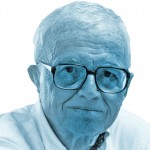Many yardsticks would be needed to measure the number of inches devoted by The New York Times in the past few weeks to the beatification of Pauline Kael, the abrasive and highly influential film critic for The New Yorker from 1968 to 1991. The occasion for those retrospective rites is the publication of several books.
One is Pauline Kael: A Life in the Dark, a biography that recapitulates the career of a writer adored by her acolytes and loathed by her enemies for her combative demeanor and messy intellectual feuds. Reviewing it in the Times, Janet Maslin said, “Her love for film has no present-day counterpart, but neither does the brazenness”… [which reflects] “the slugfest spirit of the times.” Another book is The Age of Movies: Selected Writings of Pauline Kael, an anthology by the Library of America, which admirably collects in matching editions the works of America’s literary giants. I’ll admit that I was surprised to see two decades of film journalism canonized in the same church as Lincoln, Thoreau, Emerson, Walt Whitman, and Emily Dickinson; that’s a fairly loose canon. But such is the fervor of this adulatory moment.
Reading the Times’s immensely long explications of the new books, I’m struck by how seriously all the players in Kael’s orbit took themselves, whether they were actually reviewing films or just howling from the sidelines. They were cineastes endlessly squabbling over ur-texts and the auteur theory, critics pummeling each other with pugilistic glee. In one review Kael compared Robert Altman’s Nashville to Ulysses, presumably Homer’s. Her famous 1967 deconstruction of Bonnie and Clyde, arguing that it introduced a new aesthetic of violence in American popular culture, ran for 7,000 words in The New Yorker. Some were heard to suggest that the point could have been made more concisely. When the fever finally broke, Kael looked back on the shrunken universe that she had single-handedly spun out of her fierce love of the medium. “Remember how it was in the ’60s and ’70s,” she asked, “when movies were hot and we were hot?”
I, too, was once a movie critic. As the New York Herald Tribune’s chief critic in the late 1950s, before movies became film, I reviewed more than 500 movies, many of them very good, and I don’t recall that my fellow critics and I considered ourselves hot. We were not the story; the movies were the story. We were journalists who worked for New York’s nine daily newspapers, the sole exception being Leo Mishkin, who reviewed movies for The Racing Form; he was its only provider of non-equine fare. We wrote for widely different constituencies, from the upscale Times and Herald Tribune to the downscale Daily News and Mirror, and we ourselves had little in common—though our paths crossed several times a week in smoky screening rooms—except the shared pride in our craft and a deep affection for the movies. It would never have occurred to us to write about each other.
It was the best of jobs in the best of worlds because people went about their work with enjoyment. I still run into old Hollywood press agents on the sidewalks of New York, and we fall on each other with remembered fondness and amusement. At that time Hollywood was still a small company town ruled by a half-dozen thuggish studio chiefs, who nevertheless made many wonderful movies that eased Americans through the Great Depression and World War II and helped the country to maintain its emotional balance.
My generation of movie critics, reared on those credulous films, acquiesced in their simple vision and can perhaps be blamed for perpetuating naïve “mainstream” and “middlebrow” values. But we always took the movies, if not ourselves, seriously.


